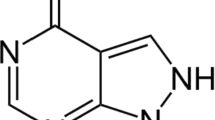Abstract
The degradation of lidocaine in aqueous solution obeys the expression k obs = (k H+[H +] + k o ) [H+]/([H + ] + K a + k′o K a([H + ] + K a) where k H+ is the rate constant for hydronium ion catalysis, and k o and k′o are the rate constants for the spontaneous (or water-catalyzed) reactions of protonated and free-base lidocaine. At 80°C, the rate constants for these processes are 1.31 × 10−7 M −l sec−1, 1.37 × 10−9 sec−1, and 7.02 × 10−9sec−1; the corresponding activation energies are 30.5, 33.8, and 26.3 kcal mol−1, respectively. It was found that the room temperature pH of maximum stability is ∼3–6 and that lidocaine is more reactive in the presence of metal ions such as Fe2+ and Cu2+. The dissociation constant, K a, for lidocaine at 25–80°C was also measured at 0.1 M ionic strength and a plot of pK a versus 1/T gave a slope of (1.88 ± 0.05) × 103 K−1 and intercept 1.56 ± 0.16.
Similar content being viewed by others
REFERENCES
T. E. Lackner, D. Baldus, C. D. Butler, C. Amyx, and G. Kessler. Am. J. Hosp. Pharm. 40:97–101 (1983).
H. L. Kirschenbaum, W. Aronoff, G. P. Perentesis, G. W. Plitz, and A. J. Cutie. Am. J. Hosp. Pharm. 39:1013–1015 (1982).
F. M. Smith and N. O. Nuessle. Am. J. Hosp. Pharm. 38:1745–1747 (1981).
K. Bullock and J. Grundy. J. Pharm. Pharmacol. 7:755–773 (1955).
S. Goto and T. Itano. Yakugaku Zasshi 99:146–154 (1979).
J. Katz. Anesthesiology 27:835–837 (1966).
E. Zollner and G. Vastagh. Pharm. Zentral. 105:369–372 (1965).
J. Hine, S.-M. King, R. Midden, and A. Sinah. J. Org. Chem. 46:3186–3189 (1981).
T. C. Bruice and F. H. Marquardt. J. Am. Chem. Soc. 84:365–370 (1962).
S. O. Eriksson and J.-O. Omdal. Acta. Pharm. Suec. 1:77–90 (1964).
G. M. Loudon and J. J. Jacob. Chem. Soc. Chem. Commun. 377–378 (1980).
G. M. Loudon, M. R. Almond, and J. N. Jacob. J. Am. Chem. Soc. 103:4508–4515 (1981).
T. Yamana, A. Tsuh, and Y. Mizukami. Chem. Pharm. Bull. 21:721–728 (1973).
H. W. Harned. Physical Chemistry of Electrolyte Solutions, Reingold, New York, 1958.
R. S. Greelet, Anal. Chem. 32:1717 (1960).
A. J. Kresge, H. J. Chen, G. L. Capen, and M. F. Powell. Can. J. Chem. 61:249–256 (1983).
C. H. Rochester. Acidity Functions, Academic Press, New York, 1971.
P. R. Bevington. Data Reduction and Error Analysis for the Physical Sciences, McGraw-Hill, New York, 1969.
R. H. Levy and M. J. Rowland. J. Pharm. Pharmacol. 24:841–847 (1972).
H. Kamaya, J. J. Hayes, Jr., and I. Ueda. Anesth. Analg. 62:1025–1030 (1983).
K. A. Wyatt and I. H. Ditman. Aust. J. Pharm. Sci. 8:77–85 (1979).
T. H. Fife and T. J. Przystas. J. Am. Chem. Soc. 108:4631–4636 (1986).
L. Gu. Personal communication.
H. Bundgaard and E. Falch. Int. J. Pharm. 23:223–237 (1985).
T. C. Bruice and S. Benkovic. Bioorganic Mechanisms, W. A. Benjamin, New York, 1966.
Author information
Authors and Affiliations
Rights and permissions
About this article
Cite this article
Powell, M.F. Stability of Lidocaine in Aqueous Solution: Effect of Temperature, pH, Buffer, and Metal Ions on Amide Hydrolysis. Pharm Res 4, 42–45 (1987). https://doi.org/10.1023/A:1016477810629
Issue Date:
DOI: https://doi.org/10.1023/A:1016477810629




